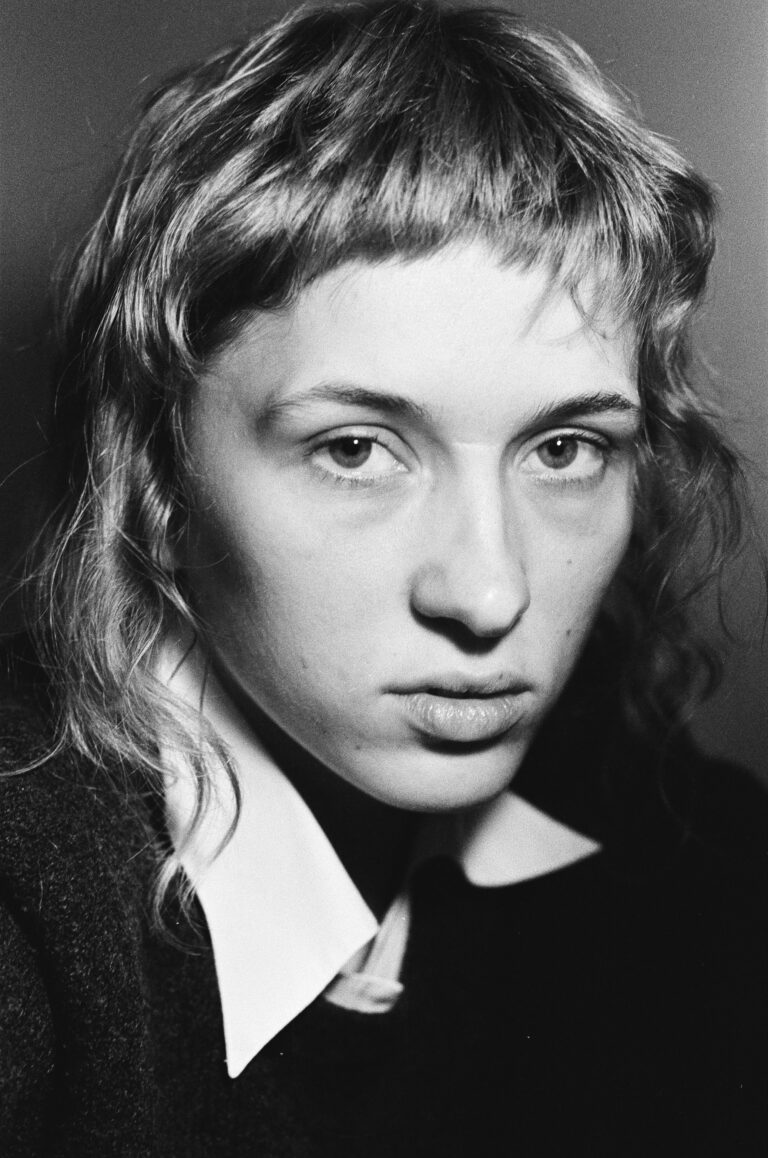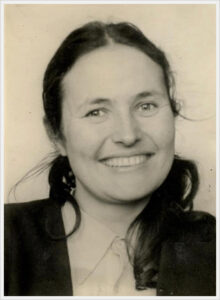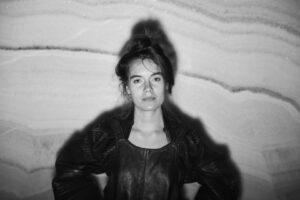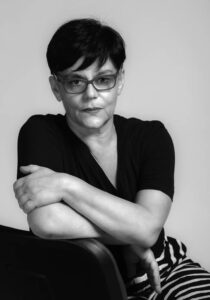Marharyta Polovinko / Маргарита Половінко

– born on March 24, 1994, in Kryvyi Rih, Ukraine. From 2012 to 2015, she studied at the Dnipro Theater and Art College in the Department of Fine Arts, specializing in easel painting. In 2019, she graduated from NAOMA with a degree in easel painting. Since 2022, she has been an active volunteer and worked on medical evacuation at the front of the Russian-Ukrainian war. After publishing a text on Secondary Archive, at the end of 2024 she joined the Armed Forces of Ukraine.
She died on April 5, 2025, on the battlefield.
All my themes are now related to the war. Previously, my works were about the shcheznyky [from Ukrainian: those who disappear; characters of Slavic mythology], about people on the periphery and outside the boundaries of cultural and social contexts. Now, when these people die due to missile strikes, they begin to exist, the war paradoxically “revives” them in a collective sense. The war shone a light, like a spotlight, and made everything visible and united in the light field: the theme of trauma, social unit, periphery, personal, collective.
In my practice since February 24, 2022, I have focused on keeping a diary123. Everything that happened around was extremely complex, while the materials became primitive: a diary, a pencil, and an eraser. The process of constant drawing and erasing.
Over these years, I have perceived the war as something illogical, unnatural, abnormal, that does not fit into any existing contexts. Over time, this understanding has become more complex. And it was at this time that blood appeared in the materials I work with45. With a pencil, I simply illustrated the primal fear. When the rethinking came, the understanding of reality became deeper, and the “monsters” disappeared. That’s when the material of blood appeared. It was necessary to extract the material not from the surface, as it was with the pencil, but from the depth.
My native Kryvyi Rih is surrounded by quarries for ore extraction, my house is located right next to one of them. Due to the ore, everything there has a red tint, and after the rain, the roads become red. Ore is like the blood of the earth, the same iron. I associate these quarries with the wounds of the earth created by people. I feel Kryvyi Rih as something absolutely constant and immovable, but it played a big role for me in understanding the war.
In the work The Bridge6, Death is depicted under a small bridge and a house for the homeless. Death became a special character for me, traveling between drawings in the form of a skeleton. Death, as if, became a hostage of these events, grew to this land. Somewhere it peeks out, somewhere it plays the flute, sometimes it comes to the grave, and sometimes it lends its back to support.
I have very few works about my own experience. One of them is written in blood7. It depicts three people loading black bags, with Death helping them. That day we had four or five dead. We went out for them with two evacuation crews, and this was my first experience of folding a person into a bag. The body had already stiffened, and it took effort to fold the arms or what was left of them.
I would like to give people the opportunity to erase the blood from these works, so that only a stain that cannot be washed out remains. When I start to paint, the blood is bright red. Just like the memory of trauma. Then the work fades, becomes brown or even green. The memory of trauma also remains, but its saturation, its color changes. If something bad happens, we immediately want to cancel it. But over time, it becomes our experience, and we want to keep that.
Physically, I currently do not have the opportunity to be present in the art world. Due to the specifics of my work, I have very little time and energy even for a non-physical presence. However, it is very important for me to understand and feel that I still have a place in civilian life, in a life with which I identify myself. For me, it is a great opportunity to have this little island where I exist as an individual, as an artist.
The text is written in cooperation with Alya Segal (2024).
1Image: Marharyta Polovinko, Diary spread, March 2022. Paper, pencil. Courtesy of the artist.2Image: Marharyta Polovinko, Mariupol, February 2022. Paper, ballpoint pen. Courtesy of the artist.
3Image: Marharyta Polovinko, Diary spread, 2022. Paper, pencil. Courtesy of the artist.
4Image: Marharyta Polovinko, February 24, 2022. Paper, blood. Courtesy of the artist.
5Image: Marharyta Polovinko, Untitled, 2023. Paper, blood. Courtesy of the artist.
6Image: Marharyta Polovinko, Death under the bridge, 2023. Paper, blood. Courtesy of the artist.
7Image: Marharyta Polovinko, Untitled, 2023. Paper, blood. Courtesy of the artist.
– Народилася 24 березня 1994 року у місті Кривий Ріг, Україна. В 2012-2015 навчалася в Дніпропетровському театрально-художньому коледжі на факультеті образотворчого мистецтва за спеціальністю станковий живопис. У 2019 році закінчила НАОМА за спеціальністю станковий живопис. З 2022 року займалася активною волонтерською діяльністю та медичною евакуацією на фронті Російсько-Української війни. Після публікації тексту на Secondary Archie, в кінці 2024 року приєдналася до лав ЗСУ.
Загинула 5 квітня 2025 року під час виконання бойового завдання.
Всі мої теми нині пов’язані з війною. Раніше мої роботи були про щезників [персонаж слов’янської міфології], про людину на периферії та поза межами культурних і соціальних контекстів. Зараз, коли ці люди помирають внаслідок ракетного обстрілу, то починають існувати, війна їх парадоксально “оживляє” в колективному сенсі. Війна навела світло, наче прожектор і зробила все видимим і об’єднаним в світлове поле: тему травми, соціальної одиниці, периферії, особистого, колективного.
У своїй практиці з 24 лютого 2022 року я зосередилася на веденні щоденника123. Все, що відбувалося навколо, було максимально складним, натомість матеріали стали примітивними: щоденник, олівець і ластик. Процес постійного малювання і стирання.
Всі ці роки війну я сприймаю як щось нелогічне, неприродне, ненормальне, що не вписується у жодні існуючі контексти. З часом це розуміння ускладнилося. І саме в цей час у матеріалах, з якими я працюю, з’явилася кров45. Олівцем я просто ілюструвала первісний страх. Коли прийшло переосмислення, розуміння реальності стало більш глибоким, а “монстри” зникли. Саме тоді з’явився матеріал крові. Треба було діставати матеріал не з поверхні, як це було з олівцем, а з глибини.
Мій рідний Кривий Ріг оточений кар’єрами з видобутку руди, мій будинок розташований якраз біля одного з них. Через руду все там має червоний відтінок, а після дощу дороги стають червоними. Руда – як кров землі, те ж залізо. Я ототожнюю ці кар’єри з ранами землі, які створили люди. Кривий Ріг я відчуваю як щось абсолютно постійне і непорушне, проте він відіграв для мене велику роль у розумінні війни.
У роботі Міст6 зображена Смерть під мостиком та будинок для безпритульних. Смерть у мене стала особливим персонажем, який подорожує між малюнками у вигляді скелета. Смерть наче стала заручником цих подій, приросла до цієї землі. Десь вона визирає, десь грає на сопілці, десь приходить на могилу, а інколи підставляє спину, щоб підтримати.
Про мій власний досвід у мене зовсім мало робіт. Одна з них написана кров’ю7. На ній три людини, які грузять чорні пакети, а Смерть їм допомагає. В той день у нас було четверо чи п’ятеро загиблих. Ми виїхали за ними двома екіпажами еваку і це був мій перший досвід складання людини у пакет. Тіло вже задубіло і доводилося докладати зусиль, щоб скласти руки або те, що від них залишилося.
Я хотіла б дати можливість людям стирати кров з цих робіт, так щоб залишився лише слід, який вже не вимивається. Коли я починаю малювати, кров яскраво-червона. Так само і спогад про травму. Потім робота тьмяніє, стає коричневою чи навіть зеленою. Спогад про травму теж залишається, але змінює свою насиченість, свій колір. Якщо щось погане стається, то ми одразу хочемо це відмінити. Але з часом це стає нашим досвідом, а його ми хочемо залишити.
Фізично я зараз не маю змоги бути присутньою в художньому світі. В силу специфіки моєї роботи навіть на безфізичну присутність у мене дуже мало часу і сил. Втім мені дуже важливо розуміти і відчувати, що в мене все ще є місце в цивільному житті, в житті, з яким я себе ототожнюю. Для мене це велика можливість – мати цей острівець, де я існую як одиниця, мисткиня.
Текст написано у співпраці з Алею Сєгал (2024).
1Зображення: Маргарита Половінко, Розворот щоденника, березень 2022 року. Папір, простий олівець. Надано авторкою.2Зображення: Маргарита Половінко, Маріуполь, лютий 2022 року. Папір, кулькова ручка. Надано авторкою.
3Зображення: Маргарита Половінко, Розворот щоденника, 2022 рік. Папір, простий олівець. Надано авторкою.
4Зображення: Маргарита Половінко, 24 лютого, 2022 рік. Папір, кров. Надано авторкою.
5Зображення: Маргарита Половінко, Без назви, 2023 рік. Папір, кров. Надано авторкою.
6Зображення: Маргарита Половінко, Смерть під мостіком, 2023 рік. Папір, кров. Надано авторкою.
7Зображення: Маргарита Половінко, Без назви, 2023 рік. Папір, кров. Надано авторкою.



